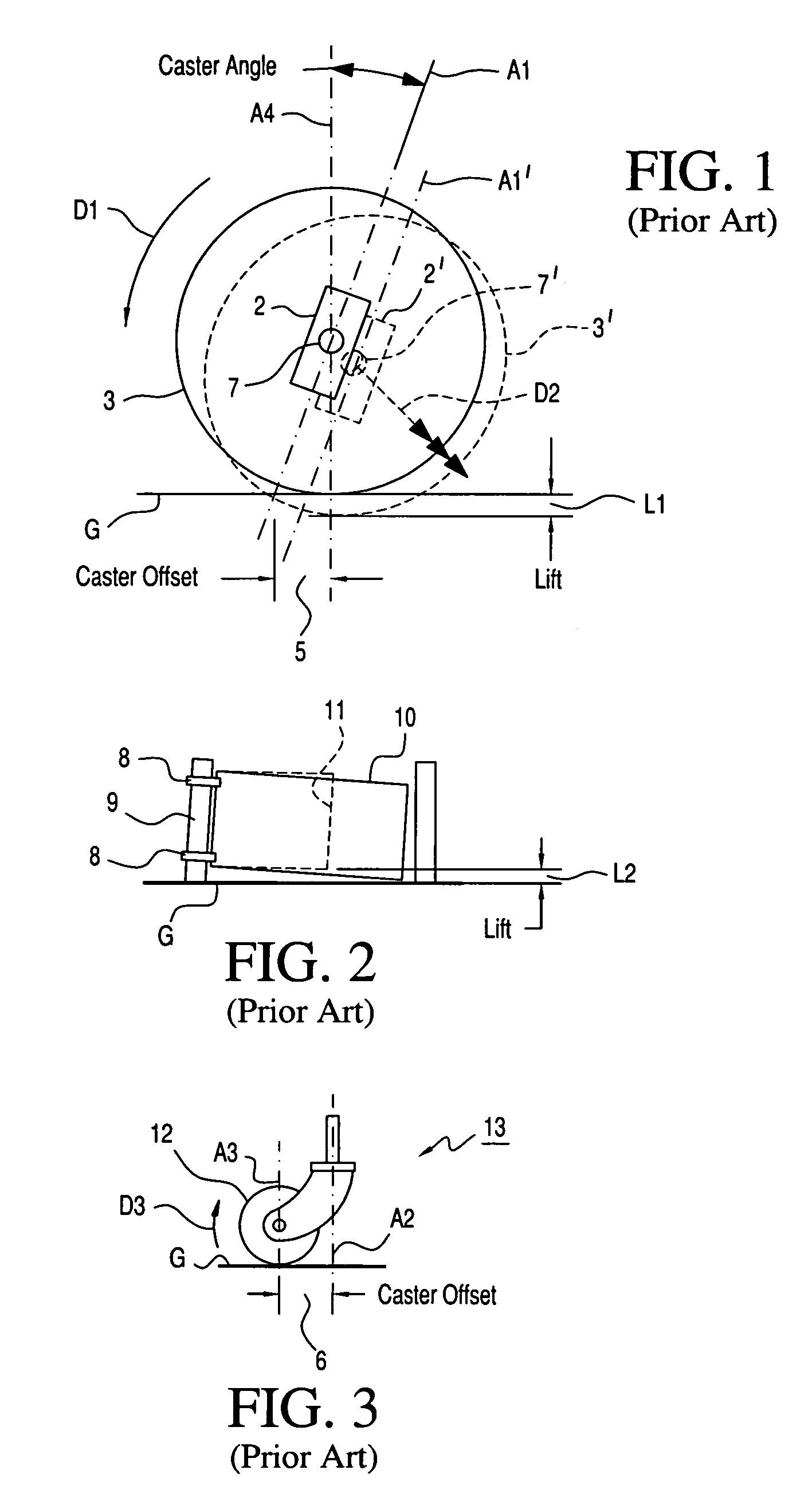The use of positive king pin angles involves compromises over the full steering spectrum because it results in positive
caster offset and thereby produces castering of the steer wheels.
Castered steer wheels also allow steering inputs from rutted and other imperfect roadway surfaces to steer back against the driver and thereby cause road wander, which is a universal driving complaint, particularly by drivers of heavy vehicles such as trucks and motor homes.
In addition, due to increased turning-lift effects, generous positive king pin angles provide significant resistance to small
radius turns, which can make city driving quite fatiguing.
These adverse effects are some of the negative aspects of attempting to achieve steering
system stability through generous amounts of positive king pin angle.
Another drawback of prior art steering systems is that spurious inputs transmitted from the roadway through the steer wheels affect substantially the entire steering
assembly before encountering any stabilizing resistance from the
steering wheel.
Such oscillations cause wear and slack in ball joints and other connections and have long been considered a
primary source of stress fatigue which can lead to
premature failure of various steering
system components.
Mechanical slack due to worn parts can also be a cause of steering
system oscillations and vehicle wandering that require constant corrections and therefore produce driver fatigue.
Keeping a vehicle tracking straight and under control currently requires an inordinate amount of driver steering corrections to counteract the adverse side effects of castered steer wheels.
The repetitive task of making numerous precise steering corrections
mile after
mile weighs heavily on a driver's physical and mental well-being, and may result in extreme driving fatigue.
My Precision Steer Wheel Control Technology (PSWCT) has brought to light incorrect technical assumptions that have been responsible for this long-standing major vehicle design oversight, which has in effect been responsible for a lack of heavy vehicle
directional stability and related highway safety issues.
For over a half a century, the driving of heavy vehicles that are lacking in
directional stability has required an inordinate amount of corrective driver steering to keep the vehicle going straight and under control.
It has been shown that the industry-wide method of slanting the king pins of the steer wheels to achieve steering wheel returnability is the major cause of the unstable behavior of the steer wheels, which results in driver fatigue and a surprising number of other drivability and operational problems.
While this low-cost simple method of achieving steering wheel returnability is desirable from a manufacturing point of view, the
resultant operational problems are very undesirable to the consumers, especially to the heavy vehicle drivers who must endure the million upon millions of miles that are many times more fatiguing to drive than they would be in a directionally stable vehicle that is not adversely affected by crosswinds.
Historians will find it hard to rationalize how the hundred-year-old method of achieving steering wheel returnability by the “turning-lift effect” could have been used for so long, without steer wheel castering problems being recognized for their negative effect on heavy vehicle drivability.
It was not for the lack of
consumer complaints about the repetitive steering corrections required to maintain directional control in
spite of road wander and steering wheel pull, about
crosswind driving fatigue, and about the cost of accelerated steer wheel tire wear.
In the beginning when the horseless
carriage first took to the road, uncomplicated simple technology was of great importance.
On either side near the gate's closed position, the turning-lift effect diminishes and becomes almost neutral such that its weight alone is not able to hold the gate in the fully closed position, requiring a suitable latch mechanism to keep it fully closed.
In a similar manner to the turning lift of the farm gate, when the steer wheels of a vehicle return toward their lowermost on-center,
straight ahead position, the turning-lift effect also diminishes and does not have enough centering force to keep the steer wheels tracking straight in the on-center driving position.
Therefore, the unstable behavior of the steer wheels near the on-center position requires that they be constantly controlled by corrective driver steering input.
The inherent lack of steer wheel
directional stability in the on-center driving position is made worse because the same slanted king pin angle that produces the turning-lift effect also produces a steer wheel castering effect that greatly adds to the unstable behavior of the steer wheels during
crosswind and crowned road driving conditions.
It is amazing that the
adverse effect of steer wheel castering has failed to be better understood over the many years because of an original misleading choice of terms.
Unfounded theories, attempting to explain how the castered wheel functions to make a vehicle directionally stable, have been repeated in various technical publications, greatly adding to the
confusion.
Crosswind driving is probably the most exhausting driving experience that heavy vehicle drivers must frequently endure because of the repetitive driver steering corrections required to keep the vehicle under control.
Crosswind driving is therefore one of the major causes of driving fatigue and related heavy vehicle highway safety issues.
During adverse road and wind conditions, the tests also demonstrated that the unstable steer wheel activity increased substantially, requiring a corresponding increase in driver steering inputs to maintain directional control.
 Login to View More
Login to View More  Login to View More
Login to View More 


